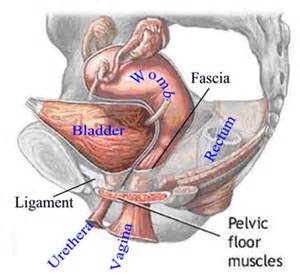Every time I evaluate a new patient (before I do a physical exam) I take the time to review the anatomy in the pelvis. It doesn’t matter if I am talking to an 11 year old and her mother or a nurse or doctor, the response is always the same “wow, I didn’t know that all that was “down there”. Even in my undergraduate physical therapy training, we barely touched on the anatomy and function of what is inside the pelvis.
I usually start from the inside out. Starting with the bony structure, the pelvic is made up with the sacrum in the middle and a pelvic bone on each side (actually each pelvic bone is 3 bones that have fuse together-but that is only important to anatomy geeks, like me).
This ring is held together by ligaments that attach the bones together like tight rubber bands. Some people have really tight ligaments and some people have really loose and stretchy ligaments. If they are too loose and stretchy, it may lead to instability, and possibly greater risk of injury to this area.
Sitting inside this pelvis are very important organs. From front to back, the organs are the bladder, uterus and the rectum. Each of these organs are also suspended by ligaments that attach them to the inside of the bony structure of the pelvis.
These ligaments can also be very tight or very loose. It is also possible that these ligaments can become damaged, during surgery, childbirth or chronic straining (think constipation or frequent coughing)
Luckily, we have some additional support from below these important organs. The pelvic floor muscles (aka levator ani) support the organs from the bottom of the pelvis. These muscle create a hammock or sling from the pubic bone in the front to the tail bone in the back. I think they look more like a bowl that supports the organs from front to back and from side to side
The pelvic floor muscles need to be able to contract, to close off the urethra (bladder opening) and the anus (rectum or bowel opening). They also need to be able to relax to allow the bladder or bowel to empty, or to allow for childbirth or intercourse. The muscles that support the bladder are the same muscles that support the bowel and create the side walls of the vaginal canal. This is why bladder, bowel and sexual issues are so closely related.
Issues can arise when these muscles either don’t contract properly or don’t relax properly. Many of the patients that I see that think they have weak muscles, actually have tight muscles that don’t relax properly.
One more layer down from the pelvic floor is the superficial perineal muscles. These muscles help to keep the rectum closed at rest, and keep the labia (lips around the vaginal and urethra opening) closed, protecting this area from bacteria and irritation. These muscles can also be affected by childbirth or chronic straining.
Sudden hormone changes, such as menopause, birth control, or after child-birth can also affect the flexibility and elasticity of these muscles. It is quite common to see patients who start having difficulty (pain) with sexual activity at these times due to changes in the muscles.
The last thing we review, which is probably the most familiar (but not familiar enough) to most women, is the external genitalia. This includes the labia majora, labia minora, clitoris, urethral opening, and vaginal opening (aka introitus).
I recommend that all women should become familiar with the appearance of this area. There is such a wide variety of what is normal, shape, texture, and color can vary quite a bit. It is very hard to tell if there has been a change, if you don’t know what it looked like before. Most of us would notice a new mole on our face or a lump in our breast, but if something feels different “down there”, could you tell if it looked different too?
Understanding your pelvic anatomy is the first step in understanding and treating any bowel, bladder or sexual issues that you may be dealing with.
Peace and Love,
NaturaPT







Thank you for the clear explanation. Looking forward to your blog. I am a physiotherapist practising in India
LikeLike
Thank you for this wonderful resource.
LikeLike